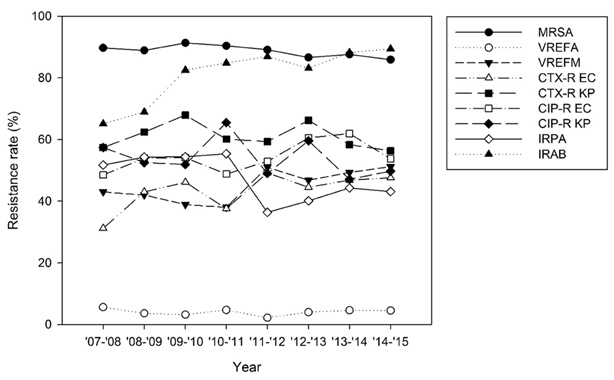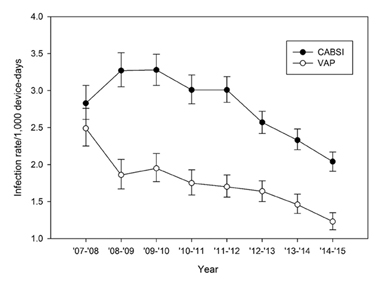Korean National Healthcare-associated Infections Surveillance System, Intensive Care Unit Module Report: Summary of Data from July 2014 through June 2015
- Affiliations
-
- 1Department of Internal Medicine, Inje University Ilsan Paik Hospital, Goyang, Korea.
- 2Department of Internal Medicine, Yonsei University College of Medicine, Seoul, Korea. seran@yuhs.ac
- 3Infection Control Office, Inje University Sanggye Paik Hospital, Seoul, Korea.
- 4Department of Infectious Diseases, Asan Medical Center, University of Ulsan College of Medicine, Seoul, Korea.
- 5Department of Infectious Diseases, Seoul National University Bundang Hospital, Seongnam, Korea.
- 6Department of Infection Prevention and Control, Soonchunhyang University Bucheon Hospital, Bucheon, Korea.
- 7Department of Internal Medicine, Ewha Womans University School of Medicine, Seoul, Korea.
- 8Department of Internal Medicine, Wonju Severance Christian Hospital, Wonju, Korea.
- 9Infection Control Office, Korea University Guro Hospital, Seoul, Korea.
- 10Department of Internal Medicine, Soonchunhyang University Seoul Hospital, Seoul, Korea.
- 11Department of Laboratory Medicine, Yonsei University College of Medicine, Seoul, Korea.
- 12Department of Infection Control, Kyunghee University Hospital, Seoul, Korea.
- 13Department of Laboratory Medicine, Hallym University College of Medicine, Chuncheon, Korea.
- 14Department of Pediatrics, Eulji University School of Medicine, Eulji General Hospital, Seoul, Korea.
- 15Division of Infectious Disease Control, Korea Centers for Disease Control and Prevention, Osong, Korea.
- 16Department of Laboratory Medicine, Wonju Severance Christian Hospital, Wonju, Korea.
- KMID: 2362896
- DOI: http://doi.org/10.14192/kjhaicp.2016.21.2.37
Abstract
- BACKGROUND
In this report, we present annual data of the intensive care unit (ICU) module of the Korean National Healthcare-associated Infections Surveillance System (KONIS) from July 2014 through June 2015.
METHODS
We performed prospective surveillance of nosocomial urinary tract infection (UTI), bloodstream infection (BSI), and pneumonia (PNEU) cases at 169 ICUs in 96 hospitals using the KONIS surveillance system. Nosocomial infection (NI) rates were calculated as the numbers of infections per 1,000 patient-days or device-days.
RESULTS
A total of 2,524 NIs were found during the study period: 699 UTIs (675 cases were urinary catheter-associated), 1,090 BSIs (932 were central line-associated), and 735 PNEUs (443 were ventilator-associated). The rate of urinary catheter-associated UTIs (CAUTI) was 0.91 cases per 1,000 device-days (95% confidence interval, 0.84-0.98), and the urinary catheter utilization ratio was 0.84 (0.839-0.841). The rate of central line-associated BSIs (CLABSI) was 2.04 (1.91-2.17), and the utilization ratio was 0.52 (0.519-0.521). The rate of ventilator-associated PNEUs was 1.23 (1.12-1.35), and the utilization ratio was 0.41 (0.409-0.411). The urinary catheter utilization ratio was lower; however, CAUTIs were more common in the ICUs of hospitals with 300-699 beds than in the ICUs of hospitals with more than 900 beds.
CONCLUSION
BSIs were the most commonly reported NIs. The rates of CAUTI and CLABSI were lower in this study period than during the previous period (July 2013 through June 2014).
Keyword
MeSH Terms
Figure
Cited by 7 articles
-
감염관리를 위한 세균학 기초
Bongyoung Kim
Korean J Healthc Assoc Infect Control Prev. 2020;25(2):79-85. doi: 10.14192/kjicp.2020.25.2.79.전국의료관련감염감시체계 중환자실 부문 결과 보고: 2018년 7월부터 2019년 6월
Eun Jin Kim, Yee Gyung Kwak, Sun Hee Kwak, Su Hui Ko, Jin Hwa Kim, Eu Suk Kim, Tae Hyong Kim, Seong Yeol Ryu, Hee-Won Moon, Sun Hee Park, Jin Young Ahn, So-Yeon Yoo, Hyeon Mi Yoo, Na Ra Yun, Mi Suk Lee, Sang-Oh Lee, Nan-hyoung Cho, Ji-youn Choi, Ki Ho Hong, Young Hwa Choi, Mi-Na Kim
Korean J Healthc Assoc Infect Control Prev. 2020;25(2):115-127. doi: 10.14192/kjicp.2020.25.2.115.Korean National Healthcare-associated Infections Surveillance System, Intensive Care Unit Module Report: Summary of Data from July 2015 through June 2016
Yee Gyung Kwak, Young Hwa Choi, Jun Yong Choi, Hyeon Mi Yoo, Sang-Oh Lee, Hong Bin Kim, Su Ha Han, Mi Suk Lee, Hyo Youl Kim, Sung Ran Kim, Tae Hyong Kim, Sun Hee Park, So-Yeon Yoo, Pyoeng Gyun Choe, Byung Wook Eun, Myoung Jin Shin, Ji-youn Choi, Hyun-Sook Koo, Young Uh, Jin-Hong Yoo
Korean J Healthc Assoc Infect Control Prev. 2017;22(1):9-20. doi: 10.14192/kjhaicp.2017.22.1.9.Korean National Healthcare-associated Infections Surveillance System, Intensive Care Unit Module Report: Summary of Data from July 2016 through June 2017
Yee Gyung Kwak, Young Hwa Choi, Jun Yong Choi, Hyeon Mi Yoo, Sang-Oh Lee, Hong Bin Kim, Su Ha Han, Mi Suk Lee, Hyo Youl Kim, Sung Ran Kim, Tae Hyong Kim, Sun Hee Park, So-Yeon Yoo, Pyoeng Gyun Choe, Byung Wook Eun, Myoung Jin Shin, Ji-youn Choi, Hyun-Sook Koo, Young Uh, Jin-Hong Yoo
Korean J Healthc Assoc Infect Control Prev. 2018;23(2):25-38. doi: 10.14192/kjhaicp.2018.23.2.25.Incidence of Catheter-associated Urinary Tract Infection in Hospitals with Less than 300 Beds
Jin Ju Park, Yu Bin Seo, Sung Ran Kim, Hye Jin Park, Joong Sik Eom, Hyeonmi Yoo, Hee Kyung Chun, Jae-Phil Choi, Jacob Lee
Korean J Healthc Assoc Infect Control Prev. 2019;24(1):11-18. doi: 10.14192/kjhaicp.2019.24.1.11.Korean National Healthcare-associated Infections Surveillance System, Intensive Care Unit Module Report: Summary of Data from July 2017 through June 2018
Eun Jin Kim, Yee Gyung Kwak, Tae Hyong Kim, Mi Suk Lee, Sang-Oh Lee, Sung Ran Kim, Sun Hee Park, Jin Young Ahn, Na Ra Yun, Seong Yeol Ryu, Eu Suk Kim, Ji-youn Choi, Hyeon Mi Yoo, Myoung Jin Shin, So-Yeon Yoo, Ki Ho Hong, Hee-Won Moon, Nan-hyoung Cho, Hee Jung Son, Su Hyun Kim, Young Hwa Choi, Mi-Na Kim
Korean J Healthc Assoc Infect Control Prev. 2019;24(2):69-80. doi: 10.14192/kjicp.2019.24.2.69.The Distribution of Multidrug-resistant Microorganisms and Treatment Status of Hospital-acquired Pneumonia/Ventilator-associated Pneumonia in Adult Intensive Care Units: a Prospective Cohort Observational Study
Youjin Chang, Kyeongman Jeon, Sang-Min Lee, Young-Jae Cho, Young Sam Kim, Yong Pil Chong, Sang-Bum Hong
J Korean Med Sci. 2021;36(41):e251. doi: 10.3346/jkms.2021.36.e251.
Reference
-
1. Lee SO, Kim S, Lee J, Kim KM, Kim BH, Kim ES, et al. Korean Nosocomial Infections Surveillance System (KONIS) Report: Data Summary from July through September 2006. Korean J Nosocomial Infect Control. 2006; 11:113–128.2. Kwak YG, Lee SO, Kim HY, Kim YK, Park ES, Jin HY, et al. Risk factors for device-associated infection related to organisational characteristics of intensive care units: findings from the Korean Nosocomial Infections Surveillance System. J Hosp Infect. 2010; 75:195–199.
Article3. Kwak YG, Choi JY, Yoo H, Lee SO, Kim HB, Han SH, et al. Korean nosocomial infections surveillance system, intensive care unit module report: summary of data from July 2013 through June 2014. Korean J Nosocomial Infect Control. 2015; 20:49–60.
Article4. Horan TC, Andrus M, Dudeck MA. CDC/NHSN surveillance definition of health care-associated infection and criteria for specific types of infections in the acute care setting. Am J Infect Control. 2008; 36:309–332.
Article5. Korean Society for Nosocomial Infection Control. KONIS Manual 2014. 5th ed. Seoul: Ceed communications; 2014. pp. 1-187.6. Jeon MH, Park WB, Kim SR, Chun HK, Han SH, Bang JH, et al. Korean nosocomial infections surveillance system, intensive care unit module report: data summary from July 2010 through June 2011. Korean J Nosocomial Infect Control. 2012; 17:28–39.7. Jeon MH, Kim TH, Kim SR, Chun HK, Han SH, Bang JH, et al. Korean nosocomial infections surveillance system, intensive care unit module report: summary of data from July 2011 through June 2012. Korean J Nosocomial Infect Control. 2014; 19:52–63.
Article8. Jeon MH, Kim TH, Kim SR, Chun HK, Han SH, Bang JH, et al. Korean nosocomial infections surveillance system, intensive care unit module report: data summary from July 2012 through June 2013. Korean J Nosocomial Infect Control. 2015; 20:37–48.
Article9. Choi JY, Kwak YG, Yoo H, Lee SO, Kim HB, Han SH, et al. Trends in the incidence rate of device-associated infections in intensive care units after the establishment of the Korean Nosocomial Infections Surveillance System. J Hosp Infect. 2015; 91:28–34.
Article10. Gastmeier P, Geffers C, Brandt C, Zuschneid I, Sohr D, Schwab F, et al. Effectiveness of a nationwide nosocomial infection surveillance system for reducing nosocomial infections. J Hosp Infect. 2006; 64:16–22.
Article11. Haley RW, Culver DH, White JW, Morgan WM, Emori TG, Munn VP, et al. The efficacy of infection surveillance and control programs in preventing nosocomial infections in US hospitals. Am J Epidemiol. 1985; 121:182–205.
Article12. Schwab F, Geffers C, Bärwolff S, Rüden H, Gastmeier P. Reducing neonatal nosocomial bloodstream infections through participation in a national surveillance system. J Hosp Infect. 2007; 65:319–325.
Article13. Kwak YG. In: Validation of the surveillance and reporting of nosocomial infection data to the Korean Nosocomial Infections Surveillance System (KONIS). Cheongju: Korean Centers for Disease Control and Prevention; 2014. pp. 1-58.14. Choi JY, Kwak YG, Yoo H, Lee SO, Kim HB, Han SH, et al. Trends in the distribution and antimicrobial susceptibility of causative pathogens of device-associated infection in Korean intensive care units from 2006 to 2013: results from the Korean Nosocomial Infections Surveillance System (KONIS). J Hosp Infect. 2016; 92:363–371.
Article
- Full Text Links
- Actions
-
Cited
- CITED
-
- Close
- Share
- Similar articles
-
- A Validation Study of Surveillance Data: Focus on the Korean National Healthcare-associated Infections Surveillance System (KONIS), Intensive Care Unit Module
- Prospective nationwide healthcare-associated infection surveillance system in South Korea
- Korean National Healthcare-associated Infections Surveillance System, Intensive Care Unit Module Report: Summary of Data from July 2020 through June 2021
- Korean National Healthcare-associated Infections Surveillance System, Intensive Care Unit Module Report: Summary of Data from July 2019 through June 2020
- Korean National Healthcare-associated Infections Surveillance System, Intensive Care Unit Module Report: Summary of Data from July 2015 through June 2016



